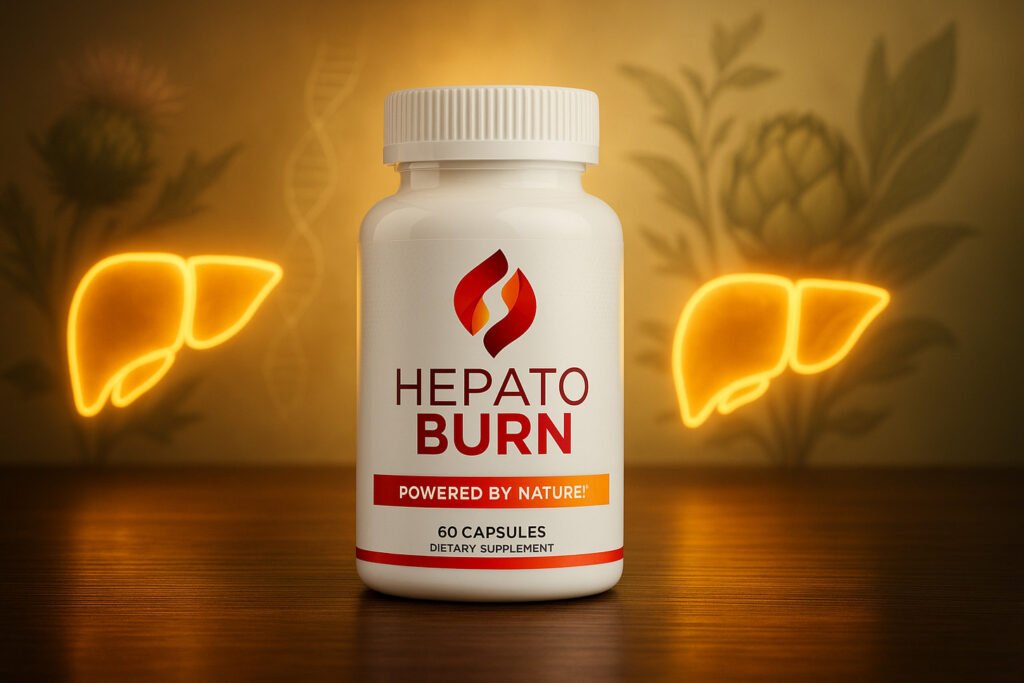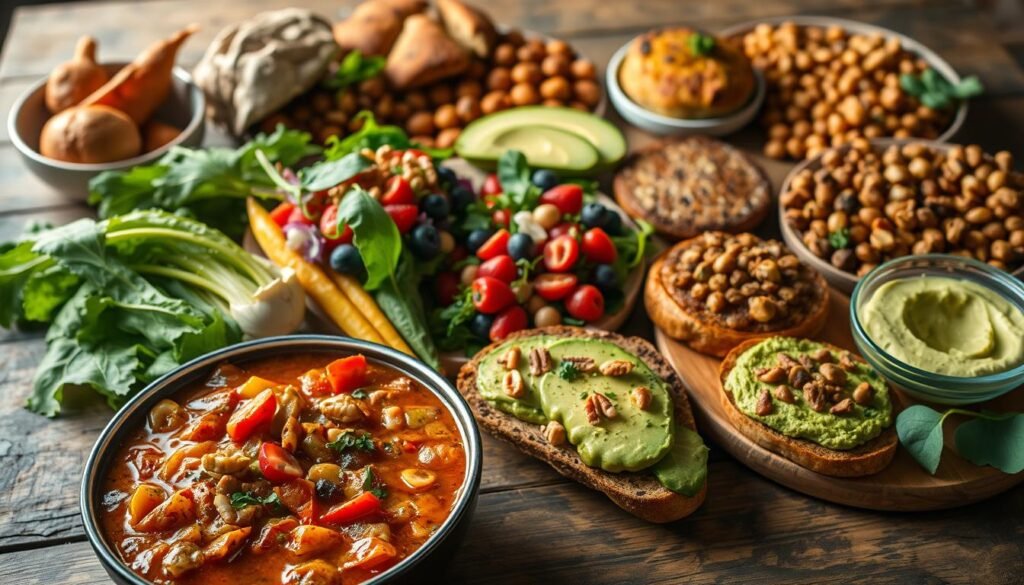
We remember the first time a simple bowl of ramen or a charred vegetable changed how we thought about meals.
We set out to prove that a plant-based diet can be both nourishing and full of flavor.
In this guide we share approachable recipes—from creamy pastas to tacos, ramen, burgers, and salads—that show how easy it is to build balanced plates at home.
We focus on whole ingredients like beans, lentils, grains, and vibrant vegetable techniques that add color and crunch.
Our aim is practical: quick weeknight wins, pantry-friendly staples, and freezer-friendly options that support a healthy diet without sacrificing taste.
Key Takeaways
- We show that plant-based meals can be health-forward and delicious.
- Recipes are grouped for fast decision-making on busy nights.
- Pantry staples like beans and grains make cooking simple and nutritious.
- Whole-food sauces and spreads boost flavor and keep dishes balanced.
- Anyone—from curious cooks to seasoned home chefs—can use this guide today.

Why we love a plant-based diet right now
Right now, more people are choosing plant-first plates for health, convenience, and big flavor.
We design this guide to match user intent: quick wins, balanced nutrients, and clear cooking tips you can use tonight.
User intent and how we serve it: quick wins, flavor, and balanced nutrients
Quick wins: 30-minute dinners and one-pot options that fit busy lives.
Flavor-first: aromatics, acids, and umami boosters so taste never trails nutrition.
What to expect in this listicle: recipes, staples, and smart swaps
Expect practical recipes like creamy pasta with white beans and nutritional yeast, jackfruit tacos, mushroom-broth ramen, and coconut curries.
We also show pantry staples and swaps to help each meal hit daily nutrients without fuss.
| Focus | Example | Benefit |
|---|---|---|
| Quick wins | 30-min pasta, one-pot chili | Fast, low cleanup |
| Staples | Beans, grains, fortified milk | Protein, iron, calcium |
| Cooking way | Roast, sauté, simmer | Max flavor and texture |
| Mindful notes | Supplements later | Whole-food-first, evidence-aware |
Vegan food essentials for everyday cooking
Everyday cooking gets simpler when we stock a few nutrient-dense staples.
Beans, lentils, and peas for protein, iron, and fiber
Legumes deliver 10–20 grams of protein per cooked cup and supply fiber, iron, zinc, folate, and antioxidants. Pairing a legume with a vitamin C-rich vegetable boosts iron absorption and helps build balanced plates.
Soaking, fermenting, and proper cooking lower antinutrients and improve digestibility. We recommend a routine of simple prep—soak when you can, rinse well, and cook until tender.
Nuts, seeds, and nut butters for healthy fats and texture
Unroasted, unsweetened nuts and seeds add healthy fats, crunch, and extra protein. Nut butters are an easy swap for creaminess that makes vegetables feel indulgent without dairy.
Tofu, tempeh, and seitan as versatile meat alternatives
Tofu and tempeh provide roughly 9–20 grams of protein per 100 grams and bring iron and calcium to meals. Tempeh fermentation may ease antinutrients, though B12 is not reliable from tempeh alone.
Seitan offers about 18 grams protein per 100 grams but is gluten-based. We limit heavily processed mock meats and rotate legumes and soy for nutrient variety.
| Protein base | Typical protein | Quick notes |
|---|---|---|
| Beans, lentils, peas (per cup) | 10–20 g | Fiber, iron; pair with vitamin C |
| Tofu / Tempeh (per 100 g) | 9–20 g | Good iron/calcium; tempeh fermented |
| Seitan (per 100 g) | ≈18 g | High protein; contains gluten |
| Nuts & seeds | 2–8 g (small serving) | Healthy fats, texture, nut butters for creaminess |
Creamy comfort: dairy-free pastas that bring the flavor
Comforting pastas can be dairy-free and still deliver deep, satisfying flavor. We focus on whole ingredients that build body and savory notes without relying on heavy cream or processed substitutes.
Creamy pasta with white beans and nutritional yeast
Pureed white beans plus nutritional yeast give us a lush, protein-rich sauce with “cheesy” depth. Add lemon for brightness and a pinch of salt to sharpen the profile.
Finish by tossing shells with reserved pasta water to emulsify and create a silky coating.
Butternut alfredo and fettuccine-style sauces
Roasted butternut squash, roasted garlic, sage, and thyme make a luxe alfredo. Blend until smooth, then fold into hot pasta for a velvety mouthfeel that mimics cream without dairy.
Weeknight lentil pasta and aglio e olio twists
Lentil pasta cooks in about 30 minutes and adds quick protein and fiber. For aglio e olio, layer garlic and olive oil, then add lemon zest, parsley, and steamed broccoli florets and stems for texture.
- Pantry ingredients: nutritional yeast, roasted nuts, citrus.
- Top with toasted pine nuts and fresh herbs for crunch.
- These sauces suit any diet and scale well for weeknight cooking.
| Sauce | Key ingredients | Time |
|---|---|---|
| White bean “cheese” | White beans, yeast, lemon | 20–25 min |
| Butternut alfredo | Squash, roasted garlic, sage | 35–40 min |
| Aglio e olio twist | Oil, garlic, lemon, broccoli | 15–20 min |
Tex-Mex and tacos night made plant-based
A taco night built from whole ingredients turns pantry staples into a celebration.
We use saucy jackfruit as a fun stand-in for chicken, spiced like jerk-style “chicken” and paired with bright mango salsa for sweet-heat balance.
Jackfruit “chicken” tacos with mango salsa
Shredded jackfruit soaks up spice and sauce. Fresh mango salsa lifts each taco with acid and sweetness. Pickled onions and cilantro finish the plate.
Black bean enchiladas and sheet-pan nachos
We layer black beans, mushrooms, and poblano peppers in enchiladas for depth that satisfies like meat fillings.
Sheet-pan nachos get bubbly under the broiler with a cashew “cheese,” avocado, pico de gallo, and extra beans for protein.
Build-your-own burrito bowls with cilantro-lime rice
Bowls start with cilantro‑lime rice, add beans, roasted vegetables, guacamole, and pickled onions so every bite delivers flavor and texture.
- Batch-cook beans and rice for an easy weeknight meal.
- Add corn, cabbage slaw, or jalapeños to adjust heat and crunch.
- Pair salsas and hot sauces to match your taste.
Note: We’ll position supplements thoughtfully when we cover HepatoBurn in Section 17 and discuss how a whole-food-first approach fits the vegan diet many vegans follow.
Noodle bowls, ramen, and fresh rolls for slurpable satisfaction
We lean on bold broths and bright sauces to make noodle bowls that hit both comfort and nutrition.
Sesame soba and peanut noodles are our go-to for fast lunches. Toss gluten-free soba with a tangy sesame dressing made from toasted seeds and peanut butter. Add scallions, shredded carrot, and a squeeze of lime for instant balance.
Sesame soba and peanut noodles for speedy lunches
These bowls use pantry staples and come together in minutes. Tossed cold, they stay springy when dressed just before serving.
Umami-packed ramen with mushroom broth
We build a mushroom-forward broth using shiitake, miso, and a dash of soy for depth. Finish with sautéed mushrooms, bok choy, scallions, and a soft tofu cube. A little chili crisp and nori lift the flavor.
Fresh spring rolls and maki for light, crunchy bites
Fresh rolls pack herbs, rice noodles, and crisp veg. Serve with a peanut or tahini dip. For rollable options, make shiitake maki with avocado and cucumber to boost nutrients.
“Whole-food broths and sauces deliver true satisfaction without processed shortcuts.”
- Top bowls with toasted sesame, nori strips, or nutritional yeast.
- Add-ons: sautéed mushrooms, bok choy, or extra tofu for protein; consider fortified plant milk in some dressings.
- Make-ahead tip: store dressing separately so cold noodle salads stay lively at lunch.
| Dish | Key boost | Time |
|---|---|---|
| Sesame soba | Toasted seeds, peanut dressing | 10–15 min |
| Mushroom ramen | Shiitake broth, soy, miso | 30–40 min |
| Fresh rolls / maki | Herbs, crunchy veg, avocado | 15–20 min |
Burgers, sandwiches, and handhelds that satisfy
Simple swaps let us build sandwiches and burgers that feel indulgent but stay centered on whole ingredients.
Best veggie burger: We blend sautéed mushrooms and toasted walnuts for deep umami, sturdy texture, and added protein. A mix of oats or cooked quinoa binds the patty without relying on processed meat substitutes.
Mushroom-walnut patties and binder tips
To keep patties juicy, we add a splash of soy, a touch of tomato paste, and leave some mushroom pieces whole for bite. Use flax or chia “eggs” or mashed potato for egg-free cohesion.
Handhelds we make again and again
Falafel wraps bake up crisp with a tahini sauce, crunchy veg, and fresh herbs for bright contrast.
BBQ jackfruit sandwiches deliver classic saucey comfort when pulled and simmered in a smoky glaze.
Chickpea salad sandwiches use lemon, dill, and celery for a deli-style version that stays fresh on toasted bread.
“Toast the bread, add pickles and greens, and the contrast turns every bite into a winner.”
- Cooking methods: griddle for sear, oven for hands-off, grill for smoky char.
- Toast bread slices to add crunch and prevent sogginess from saucy fillings.
- Meal-prep note: freeze patties between parchment layers; store fillings in airtight containers for quick assembly.
| Handheld | Key boost | Prep time |
|---|---|---|
| Mushroom-walnut burger | Umami, nuts | 25–30 min |
| BBQ jackfruit sandwich | Saucy comfort | 30–35 min |
| Chickpea salad sandwich | Bright protein | 10–15 min |
One-pot curries, chilis, and skillet dinners
One-pot dinners simplify weeknight life while packing big, layered flavor into a single pan. We favor whole ingredients, aromatics, and careful spice layering so each bite feels intentional and nourishing.
Coconut curry loaded with vegetables
We simmer coconut with onions, ginger, garlic, and warm spices, then add seasonal vegetables until tender. A squeeze of lime and chopped cilantro brighten the pot.
Time: 25–35 minutes. Serve with rice for a complete plate.
Chana masala, sesame tofu, and roasted cauliflower steak
For chana masala, we bloom spices in oil, add tomatoes and chickpeas, and simmer until tangy and thick. This skillet staple uses pantry items and feeds a crowd.
Sesame tofu gets pan-seared until crisp and pairs beautifully with steamed rice or noodles for texture and protein.
Roasted cauliflower steaks caramelize at high heat; finish them with herb oil or tahini for a satisfying centerpiece.
- These one-pot meals support iron intake by pairing legumes and leafy greens with vitamin C sides.
- Adjust spice levels and garnish with lime, cilantro, or toasted seeds to suit your taste.
- Batch-cook tips: cool, portion, and freeze most stews for easy reheats on busy nights.
“Layer spices early and finish with fresh acid — that contrast makes simple dishes craveable.”
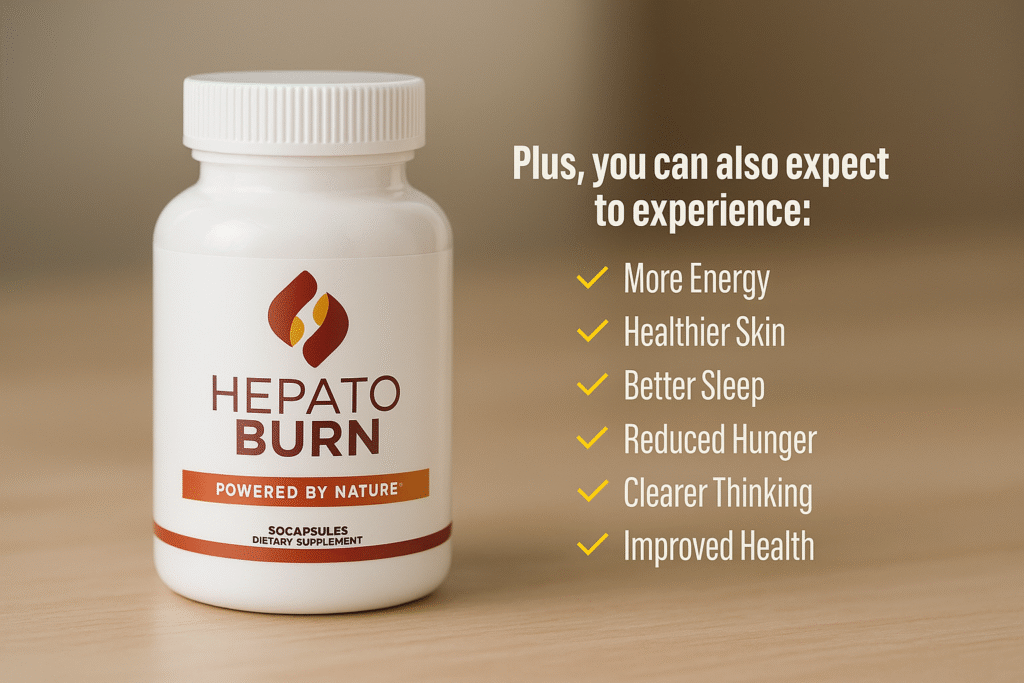
Soul-warming vegan soups for any season
A warm bowl can be both comforting and nourishing without fuss.
We start with a classic tomato base and finish it with coconut milk for a velvety, dairy-free creaminess. Roast tomatoes and garlic first to add depth, then blend until smooth for a silk finish.
For autumn, roast butternut squash until caramelized, then puree with warm spices for a plush, cozy bowl.
Hearty, pantry-friendly options
Simmer lentils with onions, curry spices, and tomatoes for a stew-like soup that tastes better the next day. It makes great lunches.
Broccoli and cauliflower soups get creaminess from blended potatoes or cashew cream, keeping texture light yet rich.
- Season with acid, heat, and fresh herbs to lift flavors.
- Top with toasted seeds, croutons, or herb oil for texture contrast.
- Freeze portions in meal-sized containers for quick reheats and simple weeknight meals paired with salad or crusty bread.
| Soup | Key approach | Best pairings |
|---|---|---|
| Tomato + coconut | Roast, blend, finish with milk | Grilled bread, green salad |
| Butternut squash | Roast squash, puree, warm spices | Toasted seeds, kale salad |
| Curry lentil | Simmer lentils, aromatics, rest overnight | Cilantro rice, pickled onions |
| Broccoli / cauliflower | Blend with potato or cashew cream | Whole-grain toast, simple slaw |
“Whole-food soups prove that comfort and nourishment can coexist without shortcuts.”
Hearty salads that double as meals
Salads become satisfying when they balance texture, protein, and bright acids. We keep bowls substantial so they travel from fridge to plate without losing snap.
Kale Caesar with briny, creamy dressing
We massage kale to soften the leaves, then toss them with a briny, creamy dressing made from cashews, lemon, capers, and a little miso. The result mimics steakhouse-level Caesar without dairy.
Crunch comes from toasted seeds and sliced avocado for healthy fats and texture.
Chickpea power bowl
Roasted chickpeas add reliable protein and a toasty bite. We layer them with roasted vegetables, a scoop of quinoa, fresh herbs, and a citrusy dressing to boost iron absorption with vitamin C.
Broccoli crunch salad
For smoky depth, we swap bacon for toasted nuts and a pinch of smoked paprika. Dried fruit adds sweet contrast, while punchy dressings—lemon zest, capers, and a touch of tahini—brighten every forkful.
- Massage kale and keep dressings separate for make-ahead meals.
- Add nuts and seeds to increase satiety and sustained energy.
- Use citrus or bell peppers to improve iron uptake from legumes and greens.
- Swap ingredients seasonally—pesto pasta salad or roasted squash work well in colder months.
“We favor whole-food-first bowls that travel well and stay exciting through simple swaps and bright dressings.”
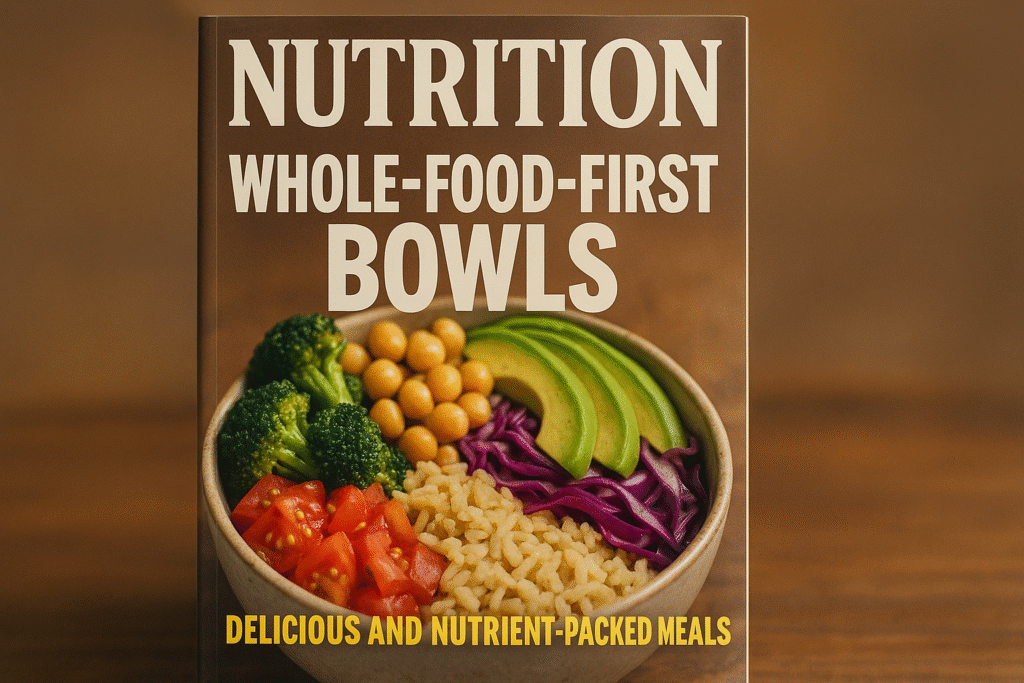
Shareable sides: potatoes, breads, and beans
Comforting sides can anchor a meal and still stay simple, pantry-friendly, and dairy-free. We focus on small lists of reliable techniques so sides arrive hot, seasoned, and crowd-ready.
Garlic mashed potatoes
Garlic mashed potatoes get richness from roasted garlic and a drizzle of olive oil instead of butter. We mash hot, add warm plant milk or stock if needed, and finish with salt and cracked pepper for balance.
Creamed spinach with coconut
Creamed spinach becomes silky with canned coconut milk and a pinch of nutmeg. It takes about 15 minutes and brightens with lemon zest or a splash of vinegar at the end.
- Roasted potatoes: high heat for crispy edges and tender centers.
- Focaccia-style bread: quick dough, olive oil, coarse salt for bakery appeal.
- Sweet potato fries and refried beans: hands-off oven and stovetop options.
- Seasoning guide: use oil, salt, fresh herbs, and acid to amplify flavor.
- Meal flow: oven or stovetop methods let sides sync with mains.
- Make-ahead tips: cool, store airtight, re-crisp in a hot oven to preserve texture.
“Classic comfort sides can be remade with whole ingredients and simple techniques to keep meals satisfying and balanced.”
Sauces, dressings, and dairy-free “cheese” moments
A handful of blended sauces can change the way we approach bowls, wraps, and noodles.
We prioritize whole-food bases that scale—nuts, seeds, beans, and pantry staples that pack body and nutrition. Below we outline simple builds and how to adapt thickness for dipping or drizzling.
Tahini, pesto, and peanut sauce
We blend tahini with lemon, garlic, and water into a pourable sauce and offer four version options: plain lemon, garlic-forward, spicy with chili, and herb-thin for salads.
Our pesto swaps lemon for Parmesan and uses extra herbs and seeds for savory depth without milk. Peanut sauce comes together with soy, lime, and a touch of sweetener for noodles and rolls.
Cashew cream, hummus, ranch, and lemon vinaigrette
Cashew cream is our base for creamy dressings and “cheesy” sauces; soak cashews, blend with water, and season to taste.
Hummus doubles as dip and spread. Vegan ranch uses cashew or oat milk plus dill and garlic. Lemon vinaigrette brightens legumes and greens in seconds.
- Nutritional yeast adds savory, cheese-like umami when you want that note without dairy.
- Match sauce version—thick for dips, thin for dressings—to the dish to increase satisfaction.
- These sauces help vegans and flexitarians enjoy meatless plates by boosting flavor and mouthfeel.
- Storage: most sauces keep 4–7 days refrigerated; freeze cashew cream for longer use.
“Sauces are the fast way to make simple ingredients feel intentional and full of flavor.”
| Sauce | Key ingredients | Best use |
|---|---|---|
| Tahini (4 versions ) | Tahini, lemon, garlic, water | Bowls, roasted veg, wraps |
| Vegan pesto | Herbs, lemon, seeds, olive oil | Pasta, sandwiches, drizzles |
| Cashew cream | Soaked cashews, water, salt | “Cheesy” sauces, ranch base |
| Peanut sauce | Peanut butter, soy, lime, sweetener | Noodles, spring rolls |
Pantry and prep: grains, legumes, and high-protein staples
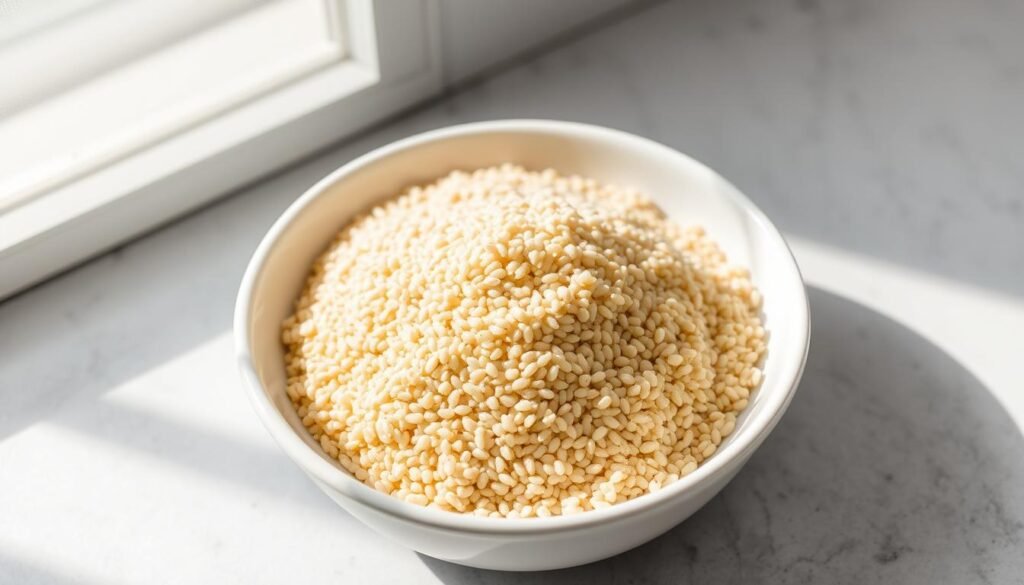
We keep a short list of reliable staples so assembling balanced meals is fast and repeatable.
Quinoa cooks in about 15 minutes and makes a quick base for bowls. Farro, couscous, and lentils fit weeknight rhythms, and Instant Pot brown rice streamlines batch prep.
For protein, we roast chickpeas until crackly and bake crispy tofu for reheatable add-ins. These methods give texture and hold up for salads, stir-fries, and grain bowls.
Quick methods and weekly flow
Cook a double batch of quinoa and brown rice on Sunday. Portion into containers, and store dressings separately to keep grains lively.
Roast chickpeas at 425°F with oil and smoked paprika for 25–30 minutes. Press and bake tofu at 400°F after marinating for a golden crust.
- Serving formula: 1 cup grain + ½–1 cup cooked beans or tofu + handful greens + tablespoon seeds.
- Rotate legumes and grains to capture varied nutrients like fiber and iron.
- Pair bowls with citrus or bell peppers to boost vitamin C and improve iron absorption.
| Staple | Time | Best use |
|---|---|---|
| Quinoa | ~15 min | Bowls, salads, grain mixes |
| Farro / Couscous / Lentils | 20–30 min | Warm sides, stews, salads |
| Instant Pot brown rice | 20–25 min (pressure) | Batch cooking, reheats well |
| Roasted chickpeas & baked tofu | 25–40 min | Snacks, toppings, protein add-ins |
“A simple prep rhythm keeps proteins, grains, and sauces ready so building meals never feels like work.”
Veg-forward basics and smart swaps
Small changes—like swapping pasta for tender squash strands—make everyday meals lighter and more versatile.
Zucchini noodles, spaghetti squash, and cauliflower rice
We spiralize zucchini for quick, warm bowls and roast spaghetti squash to mimic pasta texture the plant-based diet way.
Pulse raw cauliflower into fine grains for a fast, low-carb base that soaks up sauces and herbs.
- Quick tip: salt zucchini briefly, then pat dry to avoid watery outcomes when cooking.
- Use leftover cauliflower rice to stretch grain bowls across the week.
- Add seeds and fresh herbs after cooking for crunch and aromatic lift.
Roasted staples: butternut, peppers, beets, and Brussels sprouts
We roast butternut, peppers, beets, and Brussels sprouts on a sheet pan for sweet-savory depth that builds meals without meat.
Finish with a tamari or soy-based glaze to add umami and color.
| Vegetable | Temp | Time |
|---|---|---|
| Butternut (cubes) | 425°F | 25–30 min |
| Peppers & beets | 400°F | 20–30 min |
| Brussels sprouts (halved) | 425°F | 20–25 min |
Sheet-pan strategy: crowd less for browning, flip once, and add quick-pickled onions after roasting for brightness.
These veg-forward sides boost nutrients across the week and make mix-and-match bowls fast to assemble.
“Prepped vegetables are the easiest way to build satisfying plates on busy nights.”
We set this groundwork so Section 17 can place supplements into context—whole ingredients first, supplements second.
Nutrients that matter on a vegan diet
Smart pairing and fortified staples close common nutrient gaps in a plant-forward diet.
Protein, iron, and zinc: We prioritize legumes, tofu, tempeh, whole grains, and seeds as main protein sources. Legumes provide 10–20 g protein per cooked cup. Pairing these with vitamin C—like lemon or bell pepper—boosts non-heme iron absorption.
Calcium and vitamin D: Fortified plant milk and yogurts help us meet calcium and vitamin needs when sunlight or intake is limited. Choose fortified options to cover both nutrients.
Vitamin B12 and nutritional yeast: Fortified nutritional yeast and fortified staples supply reliable B12. Non-fortified versions are not dependable, so we favor tested products or supplements when necessary.
Omega-3s, iodine, and choline
Seeds—chia, flax, and hemp—deliver ALA omega-3s. Because conversion to EPA/DHA is limited, some of us consider algae-based EPA/DHA supplements.
Seaweed can supply iodine, but levels vary widely; we use it in moderation and avoid high-dose kelp unless advised.
Choline appears in tofu, cauliflower, and quinoa. Life-stage needs differ, so we track intake for pregnant or nursing people.
| Nutrient | Key sources | Notes |
|---|---|---|
| Protein | Legumes, soy, grains, seeds | 10–20 g per cup (legumes); mix sources daily |
| Iron & Zinc | Beans, lentils, tofu, whole grains | Soak/ferment to improve absorption; pair with vitamin C |
| Calcium & Vitamin D | Fortified plant milk & yogurts | Fortified options useful when sunlight is limited |
| Vitamin B12 | Fortified nutritional yeast, fortified staples | Use fortified products or supplements; non-fortified unreliable |
| Omega-3s | Chia, flax, hemp, algae supplements | ALA from seeds; consider algae EPA/DHA for direct benefits |
“We favor whole foods and fortified staples first, and use supplements judiciously when targets aren’t met.”
- Practical tips: Soak or ferment grains and legumes to reduce antinutrients and improve mineral bioavailability.
- Track B12 and vitamin D; choose evidence-aware supplementation if intake or blood levels are low.
- Use seeds regularly for omega-3 ALA, and consider algae-based EPA/DHA when needed.
Sweet finishes and freezer-friendly treats
Sweet finishes can be simple, freezer-ready, and surprisingly wholesome when built from ripe bananas and pantry staples.
We keep desserts short and approachable so treats fit into weeknight routines. Our focus is on whole‑ingredient versions that satisfy cravings without extra fuss.
Banana bread, brownies, and mug cakes
Banana bread toasts beautifully and pairs with nut butter for a cozy finish or an upgraded breakfast. We bake a loaf, slice, and freeze portions so a warm piece is minutes away.
Quick brownies and a microwave mug cake deliver instant satisfaction. We vary sweetness with maple or date puree and fold in nuts or chocolate for texture.
Banana “ice cream” and dairy‑free desserts
Banana “ice cream” blends frozen banana with a splash of plant milk into a soft‑serve treat. Add a spoonful of coconut for richness or toss in cocoa for a chocolate version.
- Freeze-friendly: portion bars and loaf slices for fast midweek desserts.
- Lighter approach: serve smaller portions with fresh fruit toppings.
- Party tips: offer nut butter, chopped nuts, and cocoa nibs as mix-ins for guests.
“Keep recipes flexible—swap sweeteners, add nuts, and freeze extras so dessert is always on hand.”
HepatoBurn Review insights and how we approach metabolism support
A food-first plan that emphasizes protein distribution and fiber beats quick fixes for lasting metabolic benefits.
We translate HepatoBurn Review insights into practical habits that fit daily life. Our aim is to strengthen metabolism by focusing on whole, minimally processed staples—tofu, legumes, whole grains, nuts and seeds—and by building meals that keep energy steady.
Where supplements fit: a whole-food-first, evidence-aware perspective
We position supplements as supportive, not primary. Fortified plant milks and nutritional yeast help cover vitamin and calcium gaps. When labs or intake fall short, vitamin B12, vitamin D, and algae-based omega-3s make sense under clinician guidance.
Daily habits that move the needle: protein, fiber, and cooking methods
Protein at each meal, fiber from legumes and vegetables, and resistant starches from cooled grains or potatoes are cornerstones.
- Plan-ahead protein: portion tofu, beans, or cooked lentils for quick assembly.
- Prep grains: cook a batch of intact grains and cool some to boost resistant starch.
- Simple cooking: stews, roasts, and pressure-cooked beans lower friction for consistent eating.
- Seeds: chia, flax, and hemp add healthy fats and satiety while supporting overall health.
“Metabolism support is the sum of quality diet, movement, sleep, and stress management — not a single product.”
| Focus | Why it matters | Practical tip |
|---|---|---|
| Protein distribution | Maintains muscle, supports metabolic rate | Aim for steady servings across meals |
| Fiber & resistant starch | Improves satiety, glycemic response | Include legumes, cooled rice/potatoes |
| Targeted supplements | Fill reliable gaps in intake | Test levels and consult a clinician |
For people aiming to improve long-term health, we recommend combining these habits with daily movement and regular check-ins with a healthcare professional. Personalization matters: tests help match supplements and strategies to individual needs.

Conclusion
Conclusion
A practical way forward is to build each day around a simple formula: a whole grain, a cup of legumes or tofu, and a heap of vegetables. Plan a few anchor recipes and rotate quinoa, potatoes, roasted broccoli, and cauliflower to keep meals easy and varied.
Comfort versions—mashed potatoes, dairy-free “cheese” sauces with nutritional yeast, garlic bread, and banana ice cream—prove that satisfying plates need not include meat or eggs. Keep seeds and nuts on hand and choose fortified staples for vitamin coverage.
We close with the HepatoBurn Review message: start with whole ingredients, personalize nutrients, and make your meals delicious every day. That way, the diet lasts.
FAQ
What are quick wins for adding plant-based protein to our meals?
We recommend easy staples like beans, lentils, tofu, tempeh, and edamame. Add a scoop of cooked quinoa or a handful of nuts and seeds to boost protein and texture. For fast meals, toss canned black beans into a burrito bowl with cilantro-lime rice or stir roasted chickpeas into a grain salad.
How do we make creamy, dairy-free sauces that still feel indulgent?
Cashew cream, silken tofu blended with nutritional yeast, and coconut milk provide rich mouthfeel. White beans or cooked cauliflower also create excellent bases for alfredo-style sauces. Finish with lemon, garlic, and a drizzle of olive oil for balanced flavor.
Which pantry items should we keep on hand for weeknight cooking?
Keep canned beans, brown rice, quinoa, pasta, jarred tomatoes, tahini, nut butters, oats, and a selection of spices. Shelf-stable plant milks and a jar of miso or tamari help with sauces and soups. These allow us to assemble fast, nutritious meals.
How can we ensure adequate iron and vitamin B12 in a plant-forward diet?
Pair iron-rich foods like lentils, beans, tofu, and spinach with vitamin C sources—bell peppers, citrus, or tomatoes—to improve absorption. For B12, choose fortified plant milks, nutritional yeast fortified with B12, or consider a supplement after consulting a healthcare provider.
What are simple swaps to reduce refined carbs but keep meals satisfying?
Swap white rice for brown rice, cauliflower rice, or quinoa. Replace pasta occasionally with zucchini noodles or spaghetti squash. Use whole-grain bread and add beans or tempeh to sandwiches to boost fiber and protein.
How do we build a balanced burrito bowl or taco night?
Start with a base of cilantro-lime rice or greens, add a protein like black beans, lentils, or jackfruit “chicken,” then top with roasted vegetables, avocado, salsa, and a dollop of cashew “cheese” or tahini sauce. Aim for a mix of grains, legumes, and colorful veggies for nutrients and flavor.
Which ingredients create savory, meaty texture in burgers and sandwiches?
Cooked mushrooms, walnuts, cooked lentils, and firm tofu add umami and bite. Season with soy sauce or tamari, smoked paprika, and nutritional yeast for depth. Toast the bun and add pickles and a creamy spread to enhance mouthfeel.
What are go-to comfort soups that travel well and freeze nicely?
Tomato soup made with coconut milk, butternut squash, lentil stew, and broccoli-cheddar-style soups using cashew cream freeze and reheat well. Cool completely before freezing and reheat gently to preserve texture.
How can we get enough omega-3s and iodine without fish?
Include chia, flax, and hemp seeds regularly for ALA omega-3s. For iodine, use seaweed sparingly—nori in rolls or dulse flakes on salads—or choose iodized salt. Fortified products can also help meet needs.
Are there simple dessert ideas that don’t use dairy but still satisfy cravings?
Banana “ice cream” (frozen bananas blended until creamy), brownies made with applesauce or mashed banana, and mug cakes using plant milk are quick, crowd-pleasing options. Coconut milk works well in richer desserts like puddings and custards.
How do supplements fit into a plant-first approach?
We prioritize whole foods first—legumes, soy, nuts, seeds, and fortified products—but recommend discussing supplements like B12, vitamin D, or algal omega-3s with a clinician if blood tests or dietary gaps indicate a need.
What cooking methods bring out the best flavors in vegetables?
Roasting concentrates sweetness and creates caramelized edges, sautéing with garlic and oil adds quick browning, and steaming preserves color and nutrients. Finish roasted or steamed vegetables with a bright dressing or a sprinkle of toasted seeds for texture.
How do we create satisfying weeknight dinners that require minimal cleanup?
One-pot curries, sheet-pan nachos, and skillet lentil bolognese cut down on dishes. Use pre-cooked grains or canned beans to shorten cook time, and roast vegetables on a single tray while a simple sauce simmers on the stovetop.
What are high-protein breakfast ideas to keep us full until lunch?
Overnight oats with chia and hemp seeds, tofu scramble with sautéed mushrooms and spinach, or a chickpea-flour pancake topped with nut butter and fruit offer protein and sustaining energy. Add a spoonful of nut butter or a handful of nuts for extra staying power.
